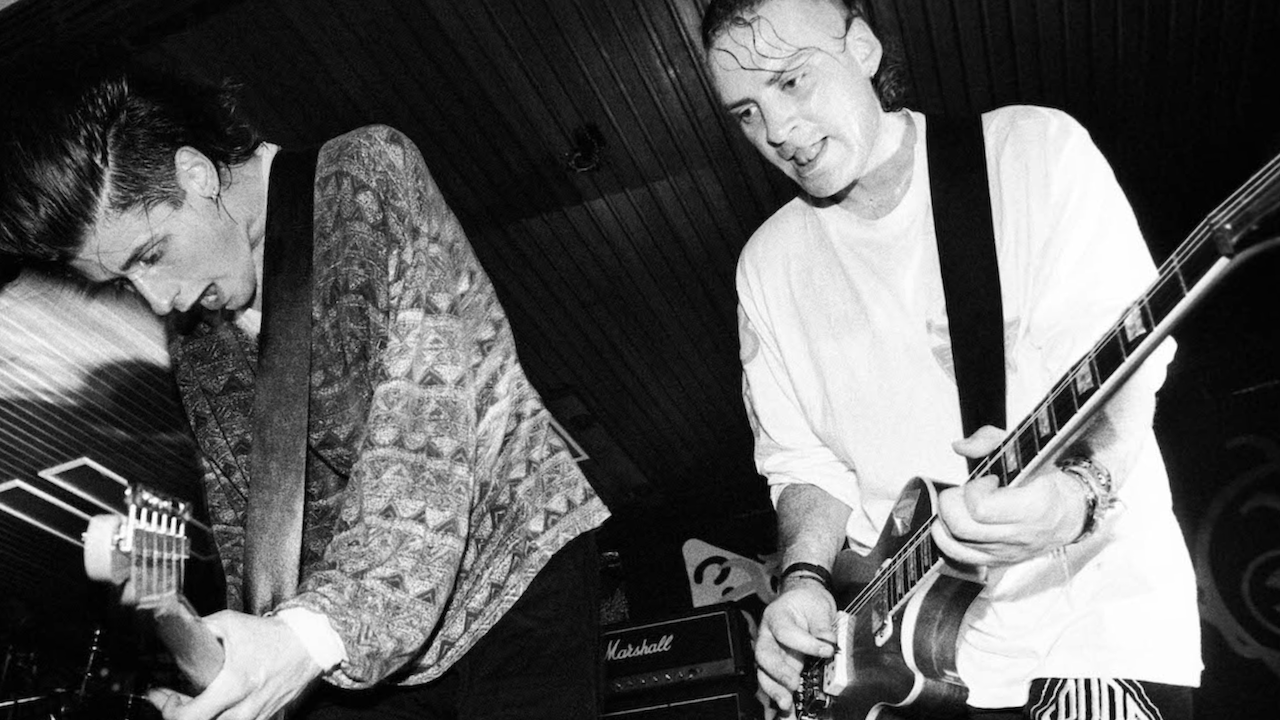
In the late 80s and early 90s, something new happened in alternative music. The Smiths had taken introspective guitar music as far as it could go. Outside of the music press, the acid house revolution seemed a far-cry from shambling guitar bands but its ecstasy-powered optimism spilled over from clubland into bands like Big Audio Dynamite, The Shamen, The Age of Chance and Pop Will Eat Itself. They mixed big beats with guitars and sampling – embracing the opportunities offered by technology and the positivity of club culture. The 'Madchester' scene hit the charts at the end of 1989, with the Stone Roses and Happy Mondays on the same episode of Top Of The Pops. Suddenly, "indie-dance" was everywhere.
Jesus Jones mashed noise rock with hip-hop and techno, classic songwriting with art-rock, and the timing was perfect. The music they made was modern and unique without ever sounding difficult or avant garde. “To be honest, that was exactly what I was aiming to do from 1988 onwards,” says frontman and songwriter Mike Edwards. “Back in those days, putting dance beats on rock music wasn’t really done. So it meant that you had a wide-open field in front of you to carve your own niche.”
Jesus Jones were critically acclaimed for a while – and then they got into the charts. When single International Bright Young Thing went to no.7 in the UK in 1990, the music press sniped: “If selling out was an Olympic event, Jesus Jones would be gold medalists.” The following year, Edwards suffered his first bout of depression. Their second LP was called Doubt: “My initial spell of super confidence started to turn into self-examination, doubt and a lack of self-confidence”
Astonishing then, that the band scored a US no.2 with Right Here, Right Now, a song brimming with optimism.
“The lyrics are obviously about the Berlin wall coming down,” says Edwards. “Simple Minds had done a cover of [Prince’s] Sign O’ The Times, and I remember sharing their enthusiasm for the song but not necessarily their version, but also thinking that Sign O’ The Times is a very down song, it has a very bleak view of the times.”
The Prince song was about AIDS, the crack epidemic, gang warfare and societal collapse. Released in 1987, by the end of the decade there was a new optimism. “I was thinking, ‘Hang on, the Berlin wall is coming down – we never thought that was going to happen’.”
So Edwards set out to revamp Sign O’ The Times for the actual times that he was living in: “Bob Dylan didn't have this to sing about,” he sang, “You know it feels good to be alive.” And he even added a reference to the Prince track: “Oh, I saw the decade in/When it seemed the world could change at the blink of an eye/And if anything, then there's your sign/Of the times."
“The bassline and drums on my demo version were entirely provided by that Sign O’ The Times loop,” he says. “I wanted a real kind of Velvet Underground guitar style and I had a two-bar loop from Sign O’ The Times that I played over.”
You can hear it, too. The Martin Philips 12" remix (above) features a bass part that is a very close relation to the one on the Prince record. “We used Martin Philips because he’d worked with The Beloved and we loved what he’d done,” he says. “But on one of their singles he’d used a sample without permission, as you did in those days, and gotten absolutely hammered for it, financially.”
Philips had produced The Beloved’s The Sun Rising which sampled US soprano Emily Van Evera. The sample was uncredited and the band had to settle out of court later. (Orbital sampled the same vocal on their track Belfast.)
Faced with a new song with Sign O’ The Times running all the way through it, Philips thought twice: “I think we’ll change that first of all.”
Right Here, Right Now was released in the UK in September 1990, but remixed for the US and released in summer 1991. It went to no.2 in July, kept off the top spot by Bryan Adams’ Everything I Do and became the most-played song on US college radio that year. Bill Clinton used it in his election campaign of 1992, Hilary Clinton used it in 2007. It was everywhere.
Jesus Jones are still going today, even if they are less optimistic. Their music recent album Passages (from 2018) opens with Where Are All The Dreams? The lyric talks about Turkeys voting for Christmas and features the line ‘I feel like the best is behind us/It’s near the end and I still need to give a damn’.
What turkeys are they talking about?
“People who voted for Brexit,” says Edwards bluntly. “That song is actually the polar opposite of Right Here, Right Now. While it captured the giddy optimism of the Berlin wall coming down – what a time to be alive – we’ve moved to the other end of the spectrum. I mean: Where Are All The Dreams? The point is in the title, really.”
For all the latest Jesus Jones news, visit their website. Jesus Joes can be found on Come Together – Adventures on The Indie Dancefloor 1989-1992, a new 4CD boxset on Cherry Red.







